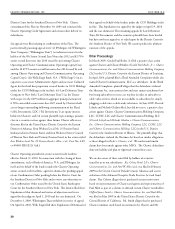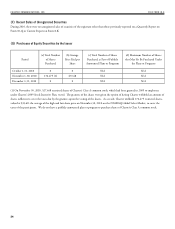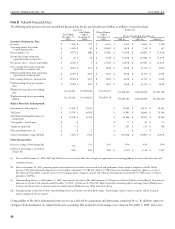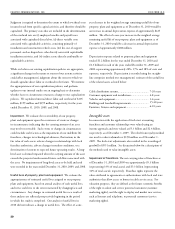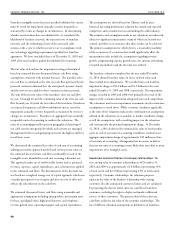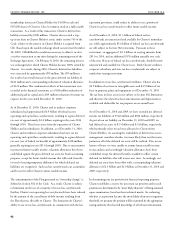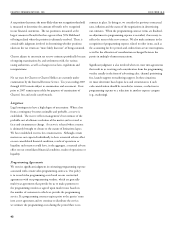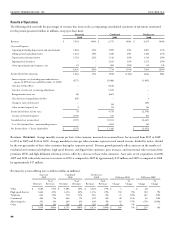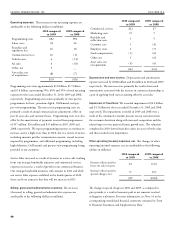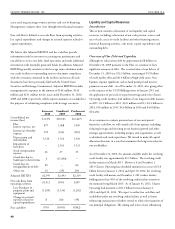Charter 2010 Annual Report Download - page 53
Download and view the complete annual report
Please find page 53 of the 2010 Charter annual report below. You can navigate through the pages in the report by either clicking on the pages listed below, or by using the keyword search tool below to find specific information within the annual report.
0
Franchise intangible assets that meet specified indefinite life criteria
must be tested for impairment annually, or more frequently as
warranted by events or changes in circumstances. In determining
whether our franchises have an indefinite life, we considered the
likelihood of franchise renewals, the expected costs of franchise
renewals, and the technological state of the associated cable
systems, with a view to whether or not we are in compliance with
any technology upgrading requirements specified in a franchise
agreement. We have concluded that as of December 31, 2010 and
2009 all of our franchises qualify for indefinite life treatment.
e fair value of franchises for impairment testing is determined
based on estimated discrete discounted future cash flows using
assumptions consistent with internal forecasts. e franchise after-
tax cash flow is calculated as the after-tax cash flow generated by the
potential customers obtained (less the anticipated customer churn),
and the new services added to those customers in future periods.
e sum of the present value of the franchises' after-tax cash flow
in years 1 through 10 and the continuing value of the after-tax cash
flow beyond year 10 yields the fair value of the franchises. Franchises
are expected to generate cash flows indefinitely and are tested for
impairment annually, or more frequently as warranted by events or
changes in circumstances. Franchises are aggregated into essentially
inseparable units of accounting to conduct the valuations. e
units of accounting generally represent geographical clustering of
our cable systems into groups by which such systems are managed.
Management believes such grouping represents the highest and best
use of those assets.
We determined the estimated fair value of each unit of accounting
utilizing an income approach model based on the present value of
the estimated discrete future cash flows attributable to each of the
intangible assets identified for each unit assuming a discount rate.
is approach makes use of unobservable factors such as projected
revenues, expenses, capital expenditures, and a discount rate applied
to the estimated cash flows. e determination of the discount rate
was based on a weighted average cost of capital approach, which uses
a market participant’s cost of equity and after-tax cost of debt and
reflects the risks inherent in the cash flows.
We estimated discounted future cash flows using reasonable and
appropriate assumptions including among others, penetration rates
for basic and digital video, high-speed Internet, and telephone;
revenue growth rates; operating margins; and capital expenditures.
e assumptions are derived based on Charter’s and its peers’
historical operating performance adjusted for current and expected
competitive and economic factors surrounding the cable industry.
e estimates and assumptions made in our valuations are inherently
subject to significant uncertainties, many of which are beyond our
control, and there is no assurance that these results can be achieved.
e primary assumptions for which there is a reasonable possibility
of the occurrence of a variation that would significantly affect the
measurement value include the assumptions regarding revenue
growth, programming expense growth rates, the amount and timing
of capital expenditures and the discount rate utilized.
e franchise valuation completed for the year ended December
31, 2010 showed franchise values in excess of book values and
thus resulted in no impairment. We recorded non-cash franchise
impairment charges of $2.2 billion and $1.5 billion for the years
ended December 31, 2009 and 2008, respectively. e impairment
charges recorded in 2009 and 2008 were primarily the result of the
impact of the economic downturn along with increased competition.
e valuations used in our impairment assessments involve numerous
assumptions as noted above. While economic conditions applicable
at the time of the valuations indicate the combination of assumptions
utilized in the valuations are reasonable, as market conditions change
so will the assumptions, with a resulting impact on the valuations
and consequently the potential impairment charge. At December
31, 2010, a 20% decline in the estimated fair value of our franchise
assets in each of our units of accounting would have resulted in an
aggregate impairment charge of approximately $49 million in three
of our units of accounting. Management has no reason to believe
that any one unit of accounting is more likely than any other to incur
impairments of its intangible assets.
Impairment and amortization of customer relationships. e
net carrying value of customer relationships as of December 31,
2010 and 2009 was approximately $2.0 billion (representing 13%
of total assets) and $2.3 billion (representing 14% of total assets),
respectively. Customer relationships, for valuation purposes,
represent the value of the business relationship with existing
customers (less the anticipated customer churn), and are calculated
by projecting the discrete future after-tax cash flows from these
customers, including the right to deploy and market additional
services to these customers. e present value of these after-tax
cash flows yields the fair value of the customer relationships. e
use of different valuation assumptions or definitions of franchises


